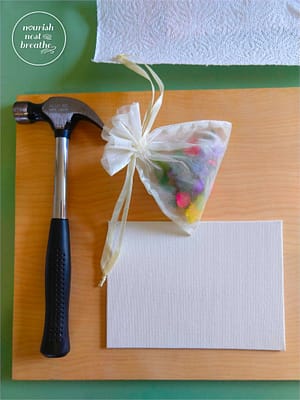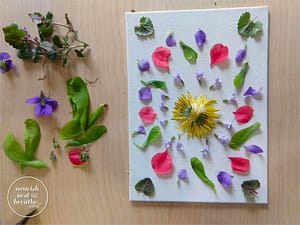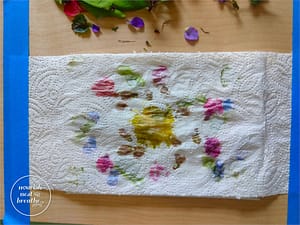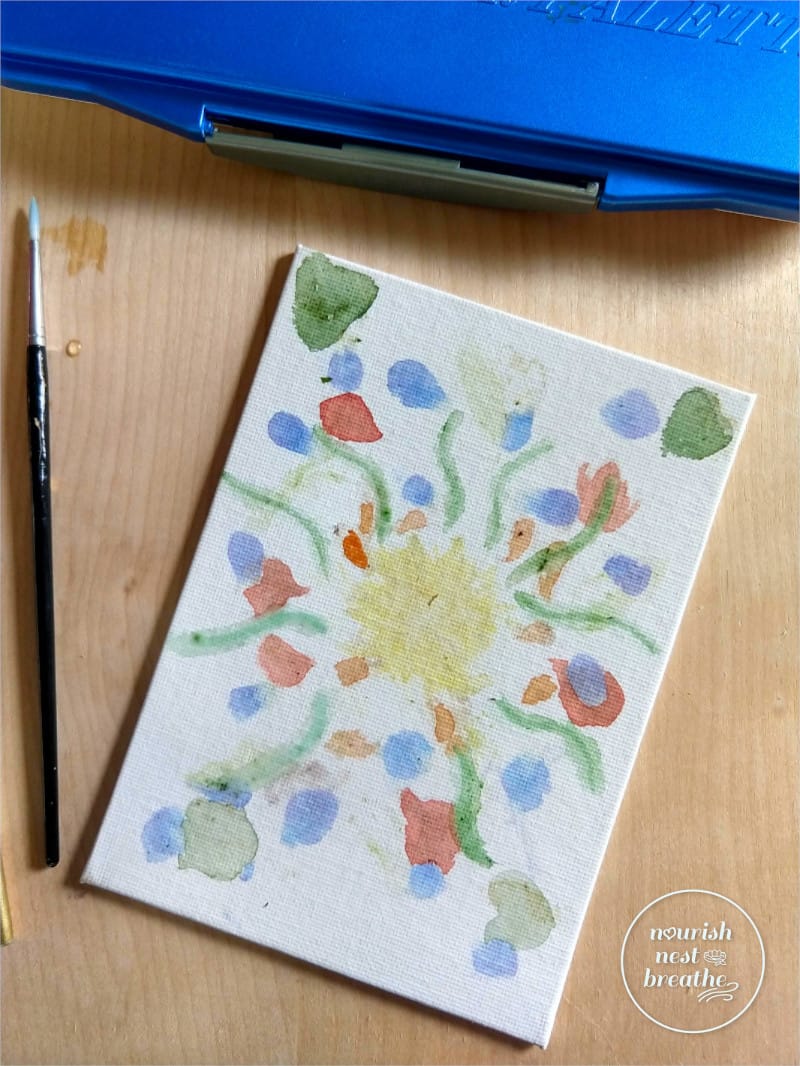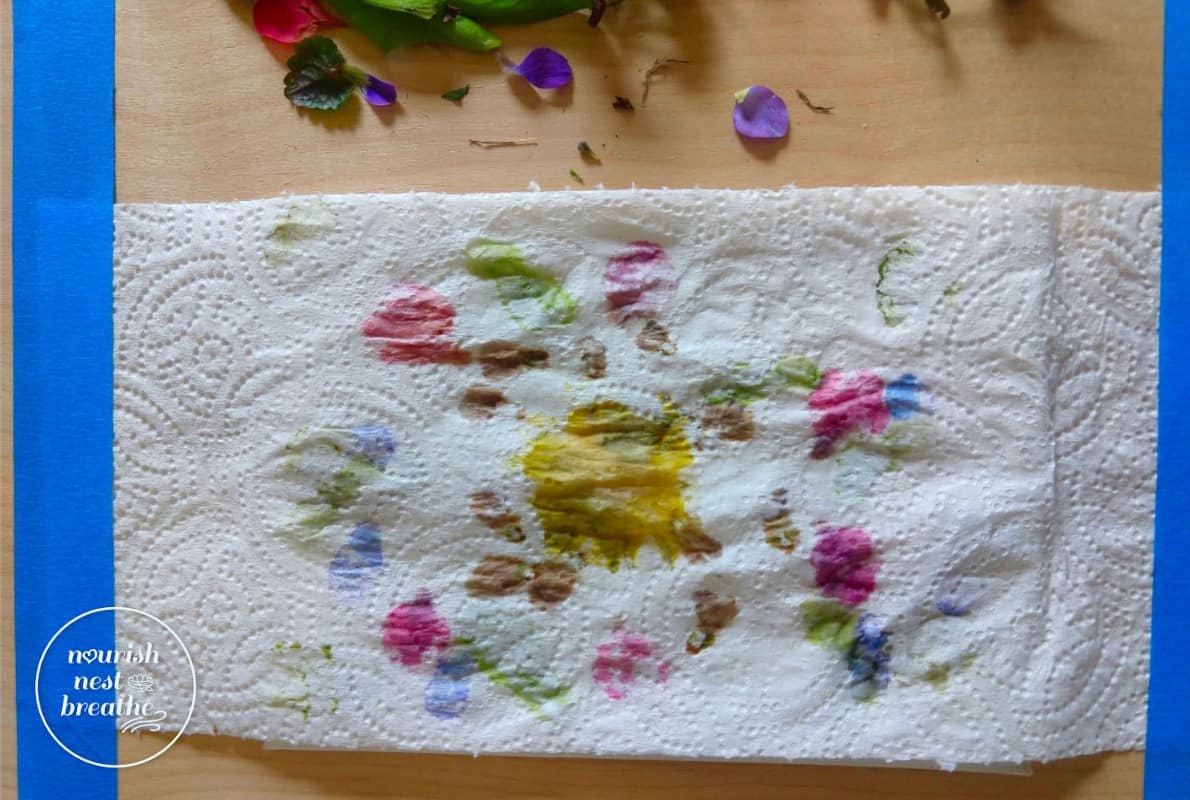
I have an amazing friend who makes stunning mandalas out of gathered natural objects. She picks up fallen leaves, twigs, rocks and flowers and creates works of art which she then photographs. Check out her social media feed which includes the mandalas (and a ton of other inspiration). Inspired both by her artwork and the variety of plants in our yard, I decided to try my hand at creating pounded flower art.
Loosely working from instructions in The Art & Craft of Pounding Flowers, I got started by gathering my supplies.
Pounded Flower Art Supplies
While the book notes you will get the best results pounding flowers on fabrics, the author also recommends preparing the fabric beforehand with a mordant. I did not want to go through the process of preparing fabric, so I went digging in my watercolor supplies. There were a few small watercolor boards (treated material on a cardboard board) which I had bought and never used for a project long since forgotten. This seemed like a great option – since they were mounted on cardboard, I already had a cushion on which to hammer.
I went out in the yard and started to pick a few of anything which looked interesting. While the book recommended several flowers which print well on paper, none of them were flowers that are part of our lawn, so I knew I would be experimenting.
I also gathered a thick scrap of plywood, a small hammer and a few paper towels. If you want to try this, you may also want some painters tape to hold the flowers and greens in place on your paper – mine shifted once I started hammering them. (I taped the paper towel instead – this didn’t seem to be particularly effective in keeping things in place.)
Making Pounded Flower Art
Once I had all my supplies gathered, my next step was to lay out my mandala. Working directly on my watercolor canvas placed on my scrap of wood, I pulled apart my flowers and greens and arranged them in a way that seemed pleasing to my eye. You want to get your plant material as flat as possible – I snipped off anything thick that held the flower or leave to a stem. Then I carefully placed a single layer of paper towel over the arrangement, and began to gently hammer each petal and green.
As I hammered, I noticed the flowers and greens had started to shift. I also noticed the colors blooming on the paper towel were not always what I expected. Several plants turned brown immediately. The violets however were much more brilliant in color than I had thought they would be.
Once I finished hammering, I lifted the paper towel and discovered something which looked very different than my original layout (and not in a good way). So I pulled out my water colors and enhanced the artwork. I brightened some colors which did not show up well, and added additional items to create balance where petals and greens had shifted from my original intention.
Why bother?
Even after I enhanced my pounded flower art with watercolors, it was still not something I would want to display in my home. So why am I even telling you about the project? While the finished project was nothing to write home about, the process of creating it was not only fun, it was a great mindfulness exercise.
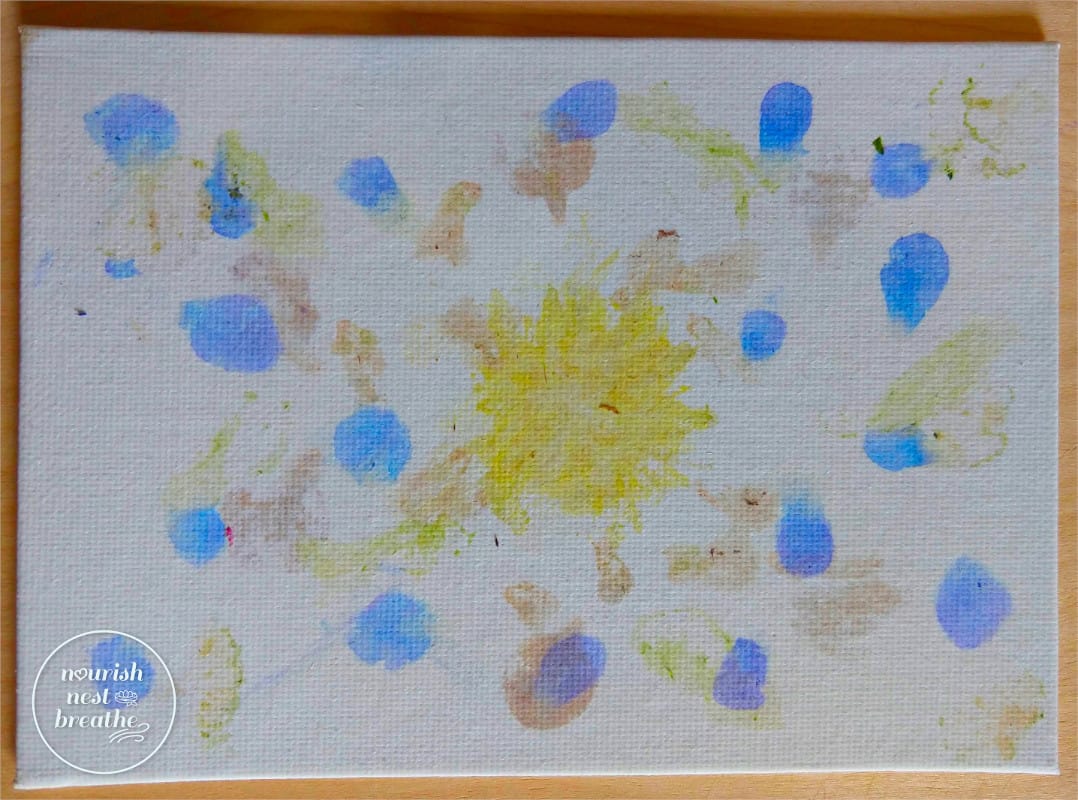 This is what my watercolor board looked like after I had hammered the plants, but before I had enhanced it with paint. Note the dandelion and violets came out brilliantly.
This is what my watercolor board looked like after I had hammered the plants, but before I had enhanced it with paint. Note the dandelion and violets came out brilliantly.The pounded flower artwork incorporates several senses and a deep connection to nature. I was able to go outside bare foot, really feeling the ground beneath my feet. Getting down close to the ground, I saw all the colors, textures and nuances of the plants growing in our yard. I spent time just listening to the birds and the wind in the trees while I was out there. When I picked them, some of the flowers and plants gave off a faint aroma.
I used a little organza bag I had received a piece of jewelry in ages ago to gather my plant material. It was like I was creating a little present for myself. The flowers were beautiful through the organza material – in the sun it looked like a little bag of jewels. And when I brought it inside to get started on the mandala, it was like opening a little present to myself.
Once I was back inside, I continued to explore the plants through touch and sight, experimenting with layout options that I found visually pleasing. Once I started to hammer the plants, several released incredible scents which I had only had the faintest exposure to before. It was like magic to get an incredible burst of fresh and floral aromas with each hammer tap on some of the greens and flowers (the ground ivy was particularly scented).
Each hammer tap also brought a bloom of color on the paper towel which would sometimes stay the same, and would sometimes change right before my eyes. Some of the color changes happened so fast that you would miss them if you blinked.
From start to finish, the project was an amazing way to explore my creativity, celebrate nature, and take a little time to slow down and appreciate the world around me with all of my senses.
Interested in trying yourself
If you want to try pounded flower art, I suggest starting with inexpensive paper – while the quality of your print might not be great, you also won’t be disappointed when 70% of the plants you hammer turn brown almost instantly. I encourage you to approach this from a place of creating an experience, rather than creating art. Coming at this project with an eye to being mindful throughout, use your five senses to explore the world around you from gathering the supplies to laying out your design to actually pounding the flowers.
If you really enjoy the process, you can begin to refine your technique and experiment with materials to get better results. And if you want to learn more about creating quality pounded flower art, I suggest The Art and Craft of Pounding Flowers. It has great tips and information on the best materials to use for printing on, how to prepare them, and which flowers will produce the best results.
Sometimes the most important part of an experience is the journey, not the destination.
Related
Leave a Reply Cancel reply
This site uses Akismet to reduce spam. Learn how your comment data is processed.
